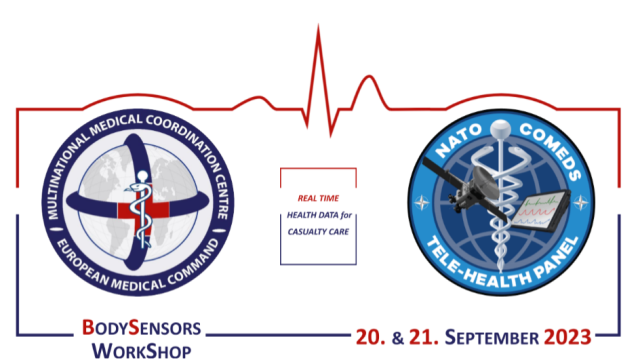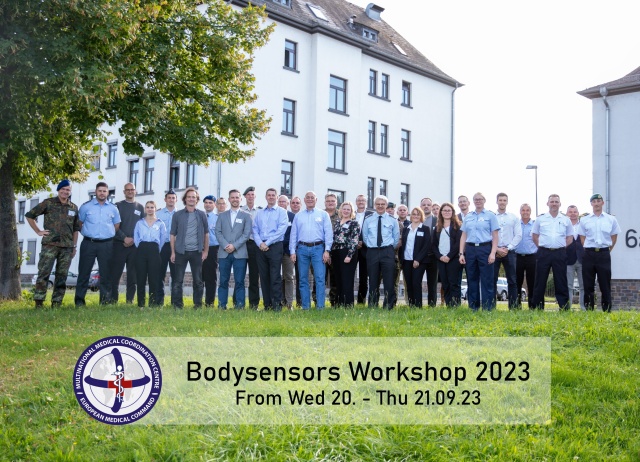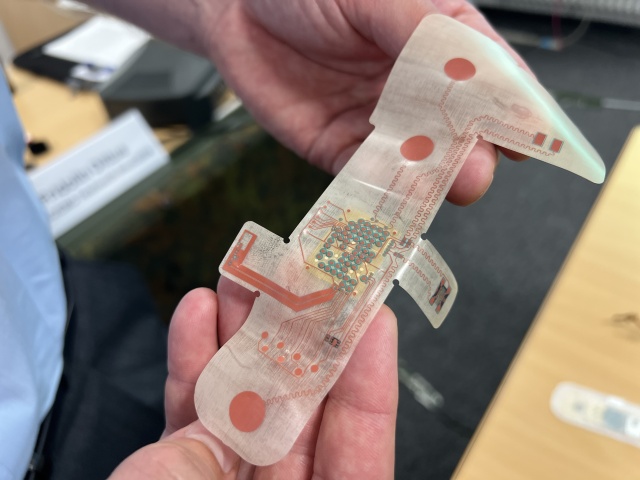
Article: Janet Licht
Bodysensors – A Tool for Medical Decision Making in Time-Critical Situations
Thinking about patient care in civilian and military situations means thinking about limiting factors like time, medical personnel, medical supply.
The experiences of recent years with major damages caused by natural disasters, e.g. the disastrous Earthquake in Turkey 2023, as well as Russia’s invasion of Ukraine have clearly shown that in both civilian and military emergency medicine challenges emerge that require to monitor, stabilize, treat and transport large numbers of injured/wounded people.
Time is a Critical Factor in Patient Care
For medical rescue workers every second counts. They have to assess the patient’s health and make decisions under enormous time pressure. The time taken to provide appropriate medical care has an immediate impact on the outcome. In this context, Bodysensors can be particularly useful. In real time, the sensors can detect rapid and precise vital parameters of wounded and sick people. Changes in vital signs can be noticed quicker. This makes the decision-making process for medical rescue workers easier and faster.
In a digitalized medical rescue chain, the detected vital parameters could be transferred to emergency services on the ground in real time. Furthermore, the patient’s data could be transmitted to a medical facility of the next level. In this way, the treatment could be supported and adjusted via telemedicine.
Furthermore, Bodysensors could be used during the process of medical evacuation (MEDEVAC). MEDEVAC is the movement of a wounded, injured or ill person under medical supervision to a medical treatment facility as an integral part of the treatment continuum. The successful management of medical evacuation requires the timely availability of suitable medical evacuation assets in sufficient numbers.
But what are “vital signs” and “Bodysensors”? Vital signs are perceptible and testable or measurable basic life functions of a person that provide information about vital body functions (vital functions). They present an overview of a patient’s state of health. The most important vital signs in humans are breathing, cardiac activity (noticeable by blood pressure and pulse), consciousness and body temperature. The quantitative recording of vital signs through measurement is called vital sign monitoring. Bodysensors are medical sensors used to monitor vital signs.
Bodysensors Workshop Series
The Multinational Medical Coordination Centre–Europe (MMCC–E) is a multinational coordinating entity within the field of medical support for its participating nations as well as institutions and headquarters of the European Union (EU) and the North Atlantic Treaty Organization (NATO). One area of interest of its Branch Tele-Health/medical CBRN (CBRN = chemical, biological, radioactive, nuclear) of the MMCC-E is Tele-Health with a focus on Bodysensors.
Already in 2021, the Tele-Health/medical CBRN Branch had organized an expert workshop about ‘Biosensors supporting Healthcare in Missions’ in cooperation with the Committee of Chiefs of Military Medical Services in NATO (COMEDS) Tele-Health Panel, comparable to a NATO telemedicine advisory committee. In this 2021 workshop, three thematic clusters were addressed: ‘Human Performance and Readiness’, ‘Health and Medical Management Applications’ and ‘Ethical and Legal Aspects of the Use of Biosensors’. The workshop proved that there is a need for further research on the reliability and validity of the generated data. It became clear that monitoring physiological data by using Bodysensors is essential when caring for the sick or injured.

Bodysensors Workshop 2023 Logo (source: MMCC-E)
In the past, the development and introduction of new technologies in emergency medicine have repeatedly led to innovative developments that resulted in adjusting medical treatment concepts and thus changed prognoses of wounded, injured or ill. Development in the Tele-Health sector is also progressing rapidly. To get an overview of the current status of the development of Bodysensors, the Tele-Health/medical CBRN Branch of the MMCC-E organised once more the hybrid two-day ‘Bodysensors Workshop 2023’ – in cooperation with the NATO COMEDS Tele- Health Panel – in Koblenz/DEU in September 2023.
In 2021, the first workshop initiated useful discussion and talks about Biosensors, whereas in the second edition of the workshop the focus shifted from the initial foundational work around concepts towards a survey of current developments of Bodysensors available in the civil and military sectors aiding injured and wounded persons. In addition, various approaches that are currently pursued regarding sensor hardware, integration and utilisation of data (e.g. hardware, applicable systems, and targeted concepts) were discussed. The aim was not only to present and discuss current projects and products, but also to think about further development lines for Bodysensors for tomorrow’s military and civilian use.
International Interest Steadily High
The broad spectrum of international participants and speakers from science, industry and the military (a total of 87 individuals from 17 different nations participated in the workshop, with 30 persons on-site and 57 joining via VTC) offered an interesting, varied

Participants of the Bodysensors Workshop 2023 (source: PiZ SanDst/Bundeswehr)
program and a lively exchange of experiences. Products currently available on the market and different research projects within the range of the topic of Bodysensors were presented. Brigadier General (MC) Dr Kowitz, Director of the MMCC-E welcomed the participants. He presented the role of the MMCC-E and the military perspective of medical support in a scenario of a collective defence event as covered in Article 5 (Art. 5) of NATO. Further, he gave a brief overview of the background of the Bodysensors workshop series and an insight into the 2021 workshop. Lieutenant Colonel (LTC) Prof Dr Scheid, NATO COMEDS Tele-Health Panel Chair, explained why the name has changed from ‘Biosensors’ to ‘Bodysensors’. The common use of the term ‘Biosensor’ was not specific and expedient enough to exactly reflect what the NATO COMEDS Telehealth Panel intended to cover while using the term. Since a definition is currently lacking at the level of the NATO standardisation office (NSO), the NATO panel members discussed a pro- posal to include and define the term ‘Bodysensors’.
Deployable in All Settings
Soldiers are being deployed to different locations and environments in different scenarios worldwide. Throughout peacetime, crises or conflict, regardless of the deployment, all military activities require medical support. The military environment sets high demands on wearable devices and the use of Bodysensors. This leads to numerous application possibilities but is challenging at the same time when it comes to Bodysensors. With regards to their use within the medical rescue chain, modular and mobile Bodysensors that can be configurated in a variety of ways and are shaped to different needs are to be considered as particularly essential. Depending on the situation, Bodysensors are either already worn close on the soldier’s body or wearable Bodysensors can be placed on the injured/wounded person’s body by paramedics or other healthcare professionals to receive vital data. Those systems must be adaptable and flexible to functioning also in complex tactical settings and terrain that is difficult to access, respectively. The detection, transmission and processing of different sensor data requires not only the appropriate digital equipment but also digital competence by all involved parties that are part of the medical rescue chain.
To underline the requirements for the operability of Bodysensors in various environments and situations, a paramedic from the German Army provided the context in which the Bodysensors could be utilised in military deployment. An introductory video set the stage for Tactical Combat Casualty Care (TCCC). He presented the different phases of care provided to a casualty on the battlefield. Initially, ‘care under fire’ is minimal care of non-medical personnel with a maximum consideration of the tactical situation. ‘Tactical field care’ provides limited, prioritised care while still under threat. ‘Tactical evacuation care’ entails the care of non-medical personnel provided during casualty evacuation (CASEVAC)- At the casualty collecting point the medical person- nel takes over the casualties and is starting the medical treatment and supervision. As a result of the tactical environment the medical personnel might be forced to provide ‘prolonged evacuation care’ during the movement of the patient to the next medical treatment facility. He pointed out that simple Bodysensors for different areas of care are required.
Prof Heller, Director of the Department of Anesthesia and Intensive Care Medicine at the University of Augsburg, emphasised the need for improvement in the triaging process. Triage is the preliminary assessment of patients or casualties in order to determine the urgency of their need for treatment as well as what type of care they require. In order to improve this process, it is essential to enhance the sensitivity and accuracy for the detection of fatal emergencies which would facilitate life-saving interventions.

Biosensor: MMCC-E mit Erlaubnis Fraunhofer Institut IZM (source: MMCC-E)
Other presentations featured a number of devices and wearable monitoring techniques, complemented by results from testing such devices under extreme conditions together with more basic research insights around the underlying technologies. Existing and future research on the integration and processing of data from biomonitoring were presented to indicate possible directions for the utilisation of wearable Bodysensors in the deployment and casualty care setting. Military and civilian experts on casualty care and mass casualty events provided insights into refining possible scenarios when using such technologies.
Key Outcome of The Workshop: ‘5+1 Parameters’
During our last workshop in 2021, it quickly became clear that monitoring vital signs with the help of Bodysensors is essential in situations of emergency medicine when caring for the sick or injured. The technical development of the Bodysensors and the subsequent transmission of the data enable the ‘digitalisation of the medical rescue chain’. Depending on its usage, the collection, secure transfer and further processing of various data are vital requirements for Bodysensors and the IT transfer associated with them. In order to digitize the medical rescue chain, modular and mobile body sensors that can be configured in different ways and adapted to different needs are required.
A key outcome of the 2023 workshop was to lay out sound foundations for the further course of procedure. This was done by identifying the relevant parameters and data sets as well as describing the types of usage categories and defining the core processes. During the workshop it was agreed that there are five elementary parameters which are essential for the monitoring and further treatment of patients: heart rate, blood pressure, respiratory rate, blood oxygen saturation, and body temperature. Bodysensors must be able to reliably measure these parameters. Since hemorrhage has been indicated to be the most frequent cause of death among wounded soldiers, it should also be possible to detect bleeding by using smart textiles. Thus, it is expedient to extend it to “5+1” parameters.
Furthermore, it was determined that the five parameters mentioned above should at best be detected by just one Bodysensor, for example in the chest area or also via ear. A comprehensive detection of bleeding can only be easily achieved using smart textiles.
Consensus on 5 essential parameters that must be measured:
• Heart rate
• Blood pressure
• Respiratory rate
• Blood oxygen saturation
• Body temperature
Essential capability additionally required:
• Blood detection
Way Ahead
The Bodysensors workshop represents a further step in the process of ‘knowledge management and transfer’ in this innovative field for the benefit of our patients.
In the following weeks after the workshop, the MMCC-E and the NATO COMEDS Tele-Health-Panel defined a small number of usage categories (scenarios) in which Bodysensors with the ‘5’ or ‘5 + 1’ functions could be used. To further advance developments, the next step based on these scenarios would be a market analysis in order to identify suitable sensors, i.e. both sensors already available as well as promising sensors still under development, meeting the requirements of the ‘5 + 1’ rule. Subsequently, these sensors should then be tested in military exercises in cooperation with the identified partners from the industry (the providers) and the military services (the users). The MMCC-E sees itself as a coordinating and facilitating element here, bringing together research institutions and development teams with the designated future users of the defined ‘use cases’.
This second edition of the workshop was very well received by the participants. The approach of bringing together industry, science and military is an expedient way for future workshops.
Author:
Lieutenant Colonel (OF-4) Janet Licht (DEU)
MMCC-E, Branch Head Telehealth/Medical CBRN
Andernacher Strasse 100
56070 Koblenz
Email: [email protected]
Date: 08/21/2024
Source: European Military Medical Services 2024











